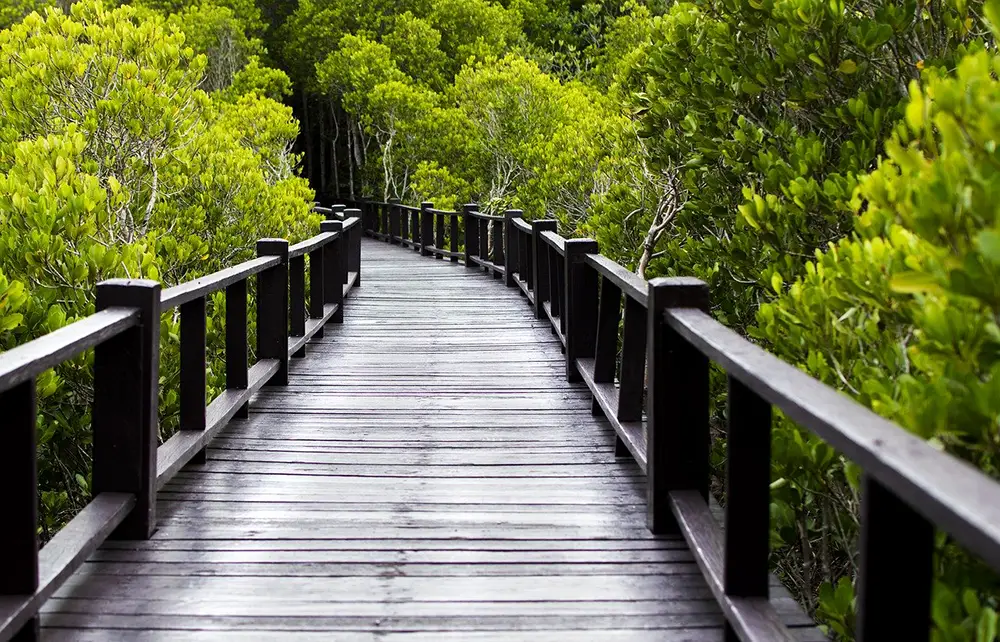Mangroves are tropical trees that thrive in conditions most plants can’t tolerate — salty, coastal waters and the interminable ebb and flow of the tide. Mangroves don’t inspire awe and wonder the way coral reefs, rainforests or wide-open grasslands do. However, with the ability to store vast amounts of carbon, mangrove forests are key weapons in the fight against climate change.

Here are 25 amazing facts about Mangrove Forests worth taking note of:
1. Mangroves are the only species of trees in the world that can tolerate saltwater. Their strategy for dealing with otherwise toxic levels of salt is to excrete it through their waxy leaves.
2. Though estimates vary, there are at least 50 — and maybe up to 110 — mangrove species, ranging in height from 2 to 10 meters, but all species feature oblong or oval-shaped leaves and share an affinity for brackish habitats.
3. Mangroves, specifically the underwater habitat their roots provide, offer critical nursing environments for juveniles of thousands of fish species, from 1-inch gobies to 10-foot sharks.
4. Mangrove forests can be found on the saltwater coasts of 118 tropical and subtropical countries, totaling more than 137,000 square kilometers — roughly the size of Greece or Arkansas.
5. The largest amount of mangrove coverage can be found in Indonesia, where mangrove trees cover some 23,000 square kilometers — that’s more than twice the size of Jamaica or roughly the size of Vermont.
6. Mangrove forests grow in intertidal zones and estuary mouths between land and sea. They anchor and protect coastal ecosystems, and make up a transitional zone between land and ocean, connecting and supporting both
7. The United States has roughly 2,500 square kilometers of mangroves — an area about the size of Luxembourg — located almost entirely in southern Florida.
8. Blue carbon ecosystems (such as mangroves, sea grasses and salt marshes) can be up to 10 times more efficient than terrestrial ecosystems at absorbing and storing carbon long term, making them a critical solution in the fight against climate change.
9. Mangrove forests — specifically, their thick, impenetrable roots — are vital to shoreline communities as natural buffers against storm surges, an increasing threat in a changing global climate with rising sea levels.
10. In Thailand, Mexico, and Indonesia, mangroves are often cut down to make room for temporary shrimp pens. But once the pens have been removed, the accumulated biowaste renders the water too toxic for most forms of life.
LEARN MORE: 5 of the Best Outdoor Activities in Costa Rica
11. Mangroves’ dense root systems inhibit the flow of tidal water and encourage the deposition of nutrient-rich sediments. But once lost, mangroves are very difficult to replant due to shifts in the very sediments the roots helped keep in place.
12. Mangroves are under threat nearly everywhere, but the problem is particularly acute in Myanmar, where the rate of deforestation is four times the global average.
13. As well as acting as a barrier against tsunamis, cyclones and hurricanes, mangrove forests can also prevent coastal erosion, protecting coral reefs from silting up, and providing a source of timber, food and traditional medicines.
14. Most mangroves live on muddy soils, but they also can grow on sand, peat, and coral rock
15. Some mangroves have unique “breathing roots”, called “pneumataphores”. They contain pores called “lenticles” through which the plants absorb oxygen. They are not active during high tide, when they are submerged. These delicate lenticels are highly susceptible to clogging by pollutants (such as oil), damage from parasites, and prolonged flooding. Over time, environmental stress can kill large swathes of mangrove forest.
16. Mangrove forests are essential nursery grounds for all kinds of marine life including fish, rays, and invertebrates.
17. Its wood can be converted into good quality charcoal and the bark produces high quality tannin which is suitable for leatherwork.
18. Red Mangroves does not respond well to cutting, and are very sensitive. If 50% or half the leaves are removed from the tree, then it will die.
19. The Black Mangrove is the most important and dominant mangrove species in the open mud flats of Guyana. The seeds are actually edible and can be prepared into a delicious meal- but caution! Unless prepared in a certain way, your meal can be toxic!
20. The Black Mangrove is used for fishing poles, charcoal, and in the production of honey, as the blossoms give the honey a unique flavour. Because the wood gives off an intense heat, it is especially prized for burning clay from which bricks are produced.
21. Two thirds of the fish we eat spend part of their life in mangroves.
22. Mangroves help protect the land from the sea during cyclones and storms.
23. When fish eggs hatch the tiny fish are easy prey for larger fish. Many newly hatched fish get protection by living among mangroves.
24. Mangroves are a very rich source of food. The mud is full of nutrients where microscopic bacteria, algae, and small creatures thrive. It is packed with life for tiny fish to feed on.
25. Mangroves can trap litter, thus preventing it from being eaten by turtles and whales.
Mangroves growing near cities and farms are often affected and some have disappeared. Changes in climate and sea level could threaten all our mangroves. It’s important to know how helpful these trees are for environment and we should consider taking steps further in conservation of these trees.
Now watch the video presentation:
If you enjoyed this video, subscribe to UpLife YouTube channel.
Sources: www.conservation.org, www.uw360.asia, scidev.net.

